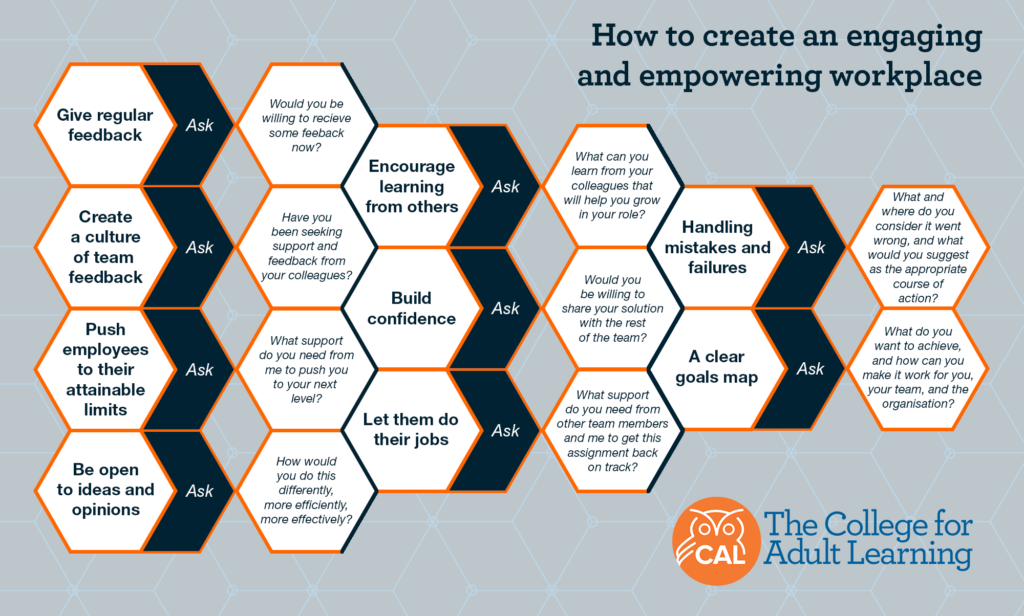
Every good manager wants tips to engage and empower employees. After all, as we become aware of the cost of an unengaged workforce, it becomes clear that managers of all kinds must redefine their traditional roles.
Globally, we see a leadership emphasis on the manager as coach. Good coaches are competent questioners. Questions help to initiate both thinking and action. No longer are employees satisfied with glib management phrases. To be successful and effective leaders, they must be active thinkers, doers, and listeners. You want to hook their minds, not bore them into disengagement and disinterest.
An engaged and empowered employee can lift the culture in every workplace because they are motivated to work with passion and they feel a profound connection with their company. They drive innovation and move the company forward, and on average, have a 51% higher productivity rate.
These are nine questions to engage employees and initiate positive coaching strategies to create an engaging environment at work. Your job as a coach is to use appropriate questions to activate each of these strategies.
Question 1: Would you be willing to receive some feedback right now?
Providing only an annual performance review is no longer effective, as employees prefer regular, specific and frequent feedback. Feedback is most valuable when it is both immediate and corrective. When giving feedback, first ask permission to give feedback. An employee’s agreement increases their willingness to hear the feedback and participate in discussion and corrections.
An appropriate opening question is: “Would you be willing to receive some feedback right now?”
Question 2: Have you been seeking support and feedback from your colleagues?
Create a culture of 360º team feedback where everyone is willing to give and receive feedback. Once teams are trained to deliver feedback, they can start with question one from the first strategy above.
As a leader, you can encourage participation with this question: “Have you been seeking support and feedback from your colleagues?”
Question 3: What support do you need from me to push you to your next level?
Bored employees are more likely to become disengaged – they need challenges to grow. That’s why it’s critical that you support and push employees to their attainable limits.
Ask this question to get the ball rolling: “What support do you need from me to push you to your next level?”
Question 4: How would you do this differently?
Listening is an essential part of coaching. When employees feel that their opinion is respected and valued, they’re far more likely to be engaged and push harder. Be open to employee ideas and opinions.
An ideal question here is: “How would you do this differently/more efficiently/more effectively?”

Question 5: What can you learn from your colleagues that will help you grow in your role?
Every employee brings a diversity of experience, strengths, weaknesses, and points of view to a work environment. Tapping into well of knowledge will engender an engaged, innovative and productive workforce. Facilitate this by encouraging learning from each other.
Encourage learning with the following question: “What can you learn from your colleagues that will help you grow in your role?”
Question 6: Would you be willing to share your solution with the rest of the team?
Giving feedback and supporting constant improvement can become critical to instilling confidence. Research on the power of recognition shows it’s best when it is immediate, specific and appropriate to the individual. Your mantra should be ‘recognise progress’.
Acknowledgement can be quite simple without it appearing to be glib praise.
Try this: “Would you be willing to share your solution with the rest of the team?”
Question 7: What support do you need to get this project back on track?
Leaders are sometimes tempted to take over jobs if they see the pace slowing down or going off track. However, this is only ever a short-term solution. Instead of taking the task off your employees hands, show them how to handle the situation by offering guidance and letting them do their jobs.
Ask: “What support do you need from other team members and me to get this assignment back on track?”
Question 8: What would you suggest as the appropriate correction for the future?
Never leave a mistake or a failure unhandled. By doing this, you lower standards and performance expectations. Always debrief mistakes, initially from the employee’s point of view and then as an exercise in correcting for the future. Handling mistakes and failures fairly and clearly is invaluable.
How to initiate this: “What and where do you consider it went wrong, and what would you suggest as the appropriate correction for the future?”
Question 9: What do you want to achieve and how can you make it work for you?
If you hope to get everyone moving in the same direction, you need to show them where to go. Goals are the clearest way to do this. Encourage each employee to create personal goals that help them develop and further their careers, as well as contribute to the benchmarks of the team and the organisation as a whole. A clear goals map is the tool that can get you there.
Start with this question: “What do you want to achieve, and how can you make it work for you, your team and the organisation?”
Your Career in Leadership and Management
Do you want to learn more about leadership and management skills you need to be a good leader, emerging job roles and salaries, and recent industry insights?
Discover your career in leadership and management.
LEADERSHIP AND MANAGEMENT CAREER PAGE






